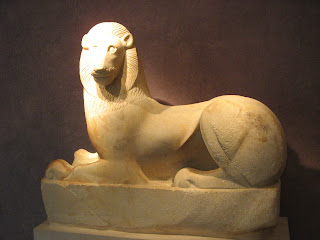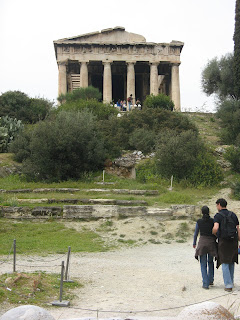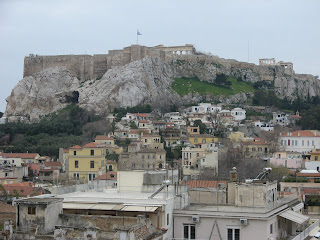Friday's adrenalin of the first full day in Athens began to run low on Saturday; I returned to the hotel about 5:30 for a couple of hours of relaxing -- you know the rest of that story.
The hotel's breakfast was a great way to start the day, but during the night a large group of French-speaking kids of high-school age must have checked into the hotel because they more-or-less filled the breakfast room. Fortunately, it was a mild morning so I took refuge on the patio along with a number of other older guests.
The hotel's breakfast was a great way to start the day, but during the night a large group of French-speaking kids of high-school age must have checked into the hotel because they more-or-less filled the breakfast room. Fortunately, it was a mild morning so I took refuge on the patio along with a number of other older guests.
Motorcycles were EVERYWHERE!!! However, when considering what automobile traffic was like, it's certainly a more efficent -- if not more comfortable -- way of maneuvering around. They weren't the least bit bothered by those little hash marks on the highway which indicate lanes for most people. NOR were you safe on the sidewalks if traffic was at a standstill. I'll never (well, rarely) again complain about motocycles in downtown Chicago.
The first of the day's three museum was the Museum of the City of Athens, which is housed in two adjoining, mid-nineteenth century buildings; one of them was the palace of King Otto and Queen Amalia. Unfortunately, the museum's collection was very sparse with a minimum of English-language signage and the audio-tour wasn't working. The grumpy guard/ticketseller and I were the only people in the museum; he made it perfectly clear that no photos were allowed, so my stay there was an abbreviated one.
One of the city's many parks was outside the City Museum, the best part of the day so far.

That left more time for the nearby National Historical Museum which focuses on the country's more "modern" history, from the Fall of Constantinople in 1453 to World War II. It's located in the Old Parliament Building which served from 1875 to 1935.

The principal destination of the day was the National Archaeological Museum, the crown jewel in the country's institutions. Its collection includes finds dating from the 7th millennium BC to the 5th century AD; The collections include Prehistorica, Sculpture, Vases and the Minor Arts, Bronze, and Egyptian Antiquities. On the way there, however, was an unfortunate recent 'cultural' site. During December's full-blown rioting by anarchists (detailed in other day's posting), the protestors wanted to demonstrate what damage they might do if provoked. They torched buildings adjacent to many of Greece's major heritage locations, including the National Archeological Museum. This store is located across the plaza from the museum and was one of several burned across the country on one night as a warning.

One of the city's many parks was outside the City Museum, the best part of the day so far.

That left more time for the nearby National Historical Museum which focuses on the country's more "modern" history, from the Fall of Constantinople in 1453 to World War II. It's located in the Old Parliament Building which served from 1875 to 1935.

The principal destination of the day was the National Archaeological Museum, the crown jewel in the country's institutions. Its collection includes finds dating from the 7th millennium BC to the 5th century AD; The collections include Prehistorica, Sculpture, Vases and the Minor Arts, Bronze, and Egyptian Antiquities. On the way there, however, was an unfortunate recent 'cultural' site. During December's full-blown rioting by anarchists (detailed in other day's posting), the protestors wanted to demonstrate what damage they might do if provoked. They torched buildings adjacent to many of Greece's major heritage locations, including the National Archeological Museum. This store is located across the plaza from the museum and was one of several burned across the country on one night as a warning.

Apparently, since the atmosphere has somewhat cooled (the anarchists protest in Sygtama Square over the weekend were mostly noise), security seems to have become less obvious in this beautiful, huge building.

One of the most stunning pieces in the museum's collection is this solid gold death mask dating back to the Mycenaean period, 17th century BC. It was captioned as "Mask of Agamemnon."

Koroi were huge stylized statues of young men and women standing guard at temples and graves. This one dates from 3d century BC.
This 140BC bronze statue of a boy riding a horse was found in pieces at the bottom of the ocean in a shipwreck off the coast of Egypt. Apparently, bronze statues from this period are relatively rare because many of them were melted down in order to produce weapons.
Bronze statue found at the bottom of the ocean with an eerie iridescent finish. There's controvery whether it represents Zeus or Poseidon. The anarchists probably don't care.
While the details are difficult to see in this picture, the dark objects are remnants of a chariot found near Sparta.
Beautiful wooden sarcophagus with mummy from 200BC in the Egyptian antiquities wing of the museum.



















































